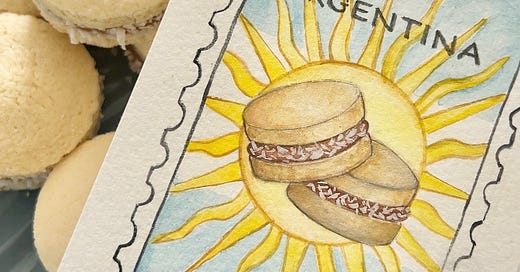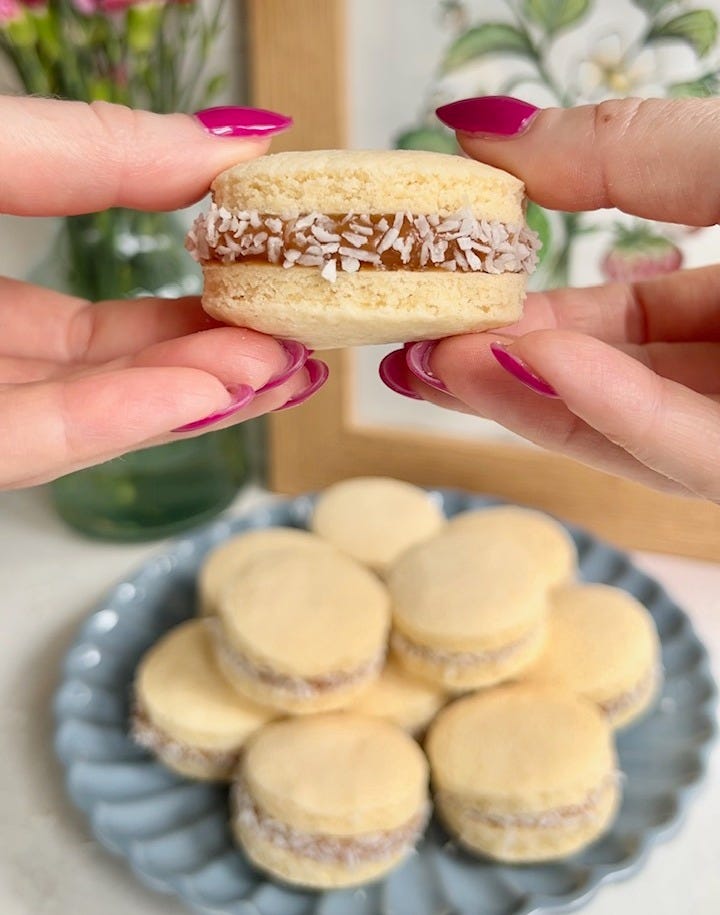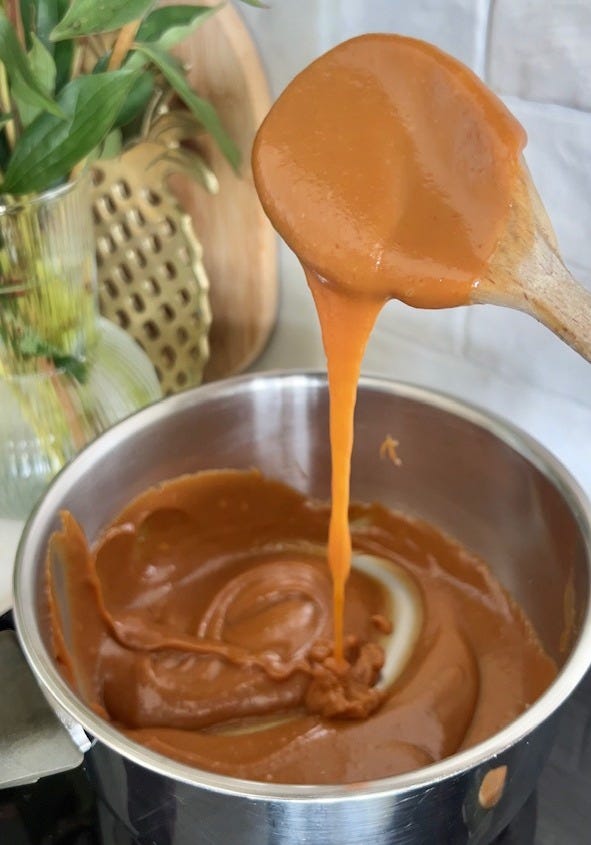I haven’t made many biscuits in this series so far, so thought it was about time I changed that, and what better than to take an imaginary culinary trip to Argentina for their delectable alfajores (pronounced ahl-fah-ho-res). Anything with Dulce De Leche in it has my vote, that’s for sure!
The Argentinian alfajor is a beloved traditional confection in Argentina, known for its soft, indulgent texture and rich flavour. The traditional variety I have made (Alfajor de Maicena) is a type of filled cookie sandwich, typically made of two round, soft biscuits filled with dulce de leche and rolled in desiccated coconut. ‘Maicena’ means cornflour, and it is this ingredient which makes the biscuit so soft and tender! They’re quite a unique biscuit and I can see why they’re so popular!
How Argentinian are they?
I know I said I was only go to make things that unequivocally came from that specific country, and are alfajores truly Argentinian? Well…maybe not technically. There isn’t a biscuit war going on, or another court battle or anything (if you’ve read my other blogs you’ll know what I’m talking about) but rather they have a long journey through history, stretching back over a thousand years and weaving through cultures, continents, and empires.
The concept is thought to have originated in the Middle East, traveling through Spain and when the Spanish colonised the Americas in the 16th Century, they brought their food traditions with them. Among them were the alfajores, but once in Latin America, alfajores began to change dramatically based on local ingredients and culinary traditions. In countries like Peru, Chile, Mexico, and especially Argentina, alfajores underwent a transformation from a nutty, honeyed confection into the soft, filled cookie sandwich I’m talking about!
Whilst many Latin American countries have their own versions of the alfajores, Argentina as a nation embraced alfajores wholeheartedly, developing its own identity for the cookie and making it a staple of everyday life. Today, Argentines consume over 6 million alfajores a day, and they come in countless regional variations - from cordobeses (with fruit and sugar glaze) to marplatenses (dipped in chocolate).
Dulce de leche is undeniably delicious, but apparently in Argentina it’s as normal as peanut butter in the U.S. or Nutella in parts of Europe. Argentina is a huge dairy-producing country, with a strong tradition of cattle farming. Dulce de leche is a great way to use fresh milk and turn it into something long-lasting and delicious.
Some random fun facts!
The largest alfajor in the world (according to Guinness World Records) was made in Uruguay in 2010. It weighed 464 kg, had a diameter of almost 2m and was 80cm tall! Imagine trying to fit that in your oven.
In Buenos Aires, there are specific weekends dedicated to celebrating the alfajor.. One notable celebration is "Alfajor Week," observed during the first week of May.
There’s also an official World Alfajor Competition, where a panel of judges selects the best alfajor from over 300 samples!
To make my alfajores: (makes about 15-18)
Biscuits:
150g unsalted butter (room temperature)
200g icing sugar
1 medium egg
1 medium egg yolk
1 tsp vanilla extract
Zest of 1/2 lemon
150g plain flour
225g cornflour
1/2 tsp baking powder
Pinch of salt
Dulce de Leche:
50g caster sugar
50g unsalted butter
50ml whole milk
1 tin (397g) condensed milk
30g desiccated coconut (to dip)
Method:
Cream together the butter and icing sugar until smooth, then add the eggs, vanilla and lemon zest.
Sift in the flour, cornflour, baking powder and salt, and bring together to a smooth dough.
Wrap in cling film and chill in the fridge for half an hour.
Lightly dust your worktop with flour, then roll out to around 3/4cm thick.
With a 2inch cookie/pastry cutter, cut into rounds, and re-roll the dough until you’ve used it all up.
Place the rounds onto a lined baking tray (with enough room for them to spread) and chill in the fridge until they are solid.
Bake at 175C (fan) for around 10 minutes, and don’t let them brown. Remove from the oven (I actually used the cutter to trim them while they were still warm as I wanted them to be perfectly round, but this is not necessary!) and leave to cool.
For the Dulche de Leche, melt the sugar in a saucepan over a low to medium heat until golden, then stir in the butter until it melts, and then add the milk.
Add the condensed milk, mixing until combined, then over a medium heat, let the mixture bubble whilst stirring.
Keep going until it thickens, and after about 10 minutes, turn the heat down so that it stops bubbling. It should be thick enough that you can drag a spoon along the bottom of the pan and see the bottom.
Let it cool fully and to assemble the biscuit, pipe a thick blob on the bottom of one biscuit and sandwich with another, before rolling in the coconut.
Don’t forget to check out my other Illustrated Bakes from Around the World pages to learn more about different delicacies from all over the world, and the stories and recipes behind them!







These look absolutely amazing Alice great job as always and amazing drawing and painting you are a amazing and talented artist Alice